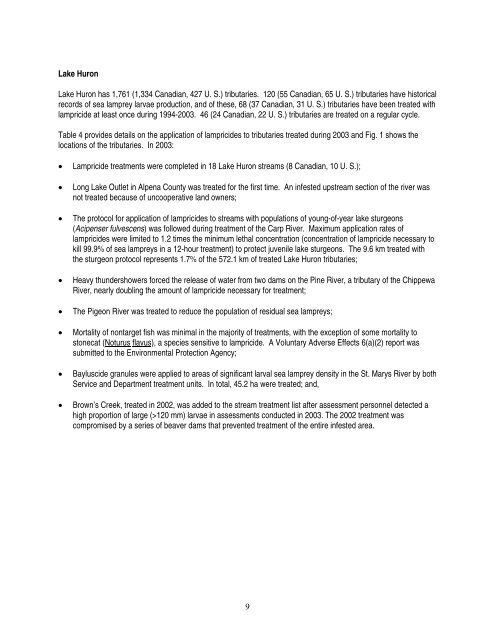2003 Report - Great Lakes Fishery Commission
2003 Report - Great Lakes Fishery Commission
2003 Report - Great Lakes Fishery Commission
You also want an ePaper? Increase the reach of your titles
YUMPU automatically turns print PDFs into web optimized ePapers that Google loves.
Lake Huron<br />
Lake Huron has 1,761 (1,334 Canadian, 427 U. S.) tributaries. 120 (55 Canadian, 65 U. S.) tributaries have historical<br />
records of sea lamprey larvae production, and of these, 68 (37 Canadian, 31 U. S.) tributaries have been treated with<br />
lampricide at least once during 1994-<strong>2003</strong>. 46 (24 Canadian, 22 U. S.) tributaries are treated on a regular cycle.<br />
Table 4 provides details on the application of lampricides to tributaries treated during <strong>2003</strong> and Fig. 1 shows the<br />
locations of the tributaries. In <strong>2003</strong>:<br />
• Lampricide treatments were completed in 18 Lake Huron streams (8 Canadian, 10 U. S.);<br />
• Long Lake Outlet in Alpena County was treated for the first time. An infested upstream section of the river was<br />
not treated because of uncooperative land owners;<br />
• The protocol for application of lampricides to streams with populations of young-of-year lake sturgeons<br />
(Acipenser fulvescens) was followed during treatment of the Carp River. Maximum application rates of<br />
lampricides were limited to 1.2 times the minimum lethal concentration (concentration of lampricide necessary to<br />
kill 99.9% of sea lampreys in a 12-hour treatment) to protect juvenile lake sturgeons. The 9.6 km treated with<br />
the sturgeon protocol represents 1.7% of the 572.1 km of treated Lake Huron tributaries;<br />
• Heavy thundershowers forced the release of water from two dams on the Pine River, a tributary of the Chippewa<br />
River, nearly doubling the amount of lampricide necessary for treatment;<br />
• The Pigeon River was treated to reduce the population of residual sea lampreys;<br />
• Mortality of nontarget fish was minimal in the majority of treatments, with the exception of some mortality to<br />
stonecat (Noturus flavus), a species sensitive to lampricide. A Voluntary Adverse Effects 6(a)(2) report was<br />
submitted to the Environmental Protection Agency;<br />
• Bayluscide granules were applied to areas of significant larval sea lamprey density in the St. Marys River by both<br />
Service and Department treatment units. In total, 45.2 ha were treated; and,<br />
• Brown’s Creek, treated in 2002, was added to the stream treatment list after assessment personnel detected a<br />
high proportion of large (>120 mm) larvae in assessments conducted in <strong>2003</strong>. The 2002 treatment was<br />
compromised by a series of beaver dams that prevented treatment of the entire infested area.<br />
9
















